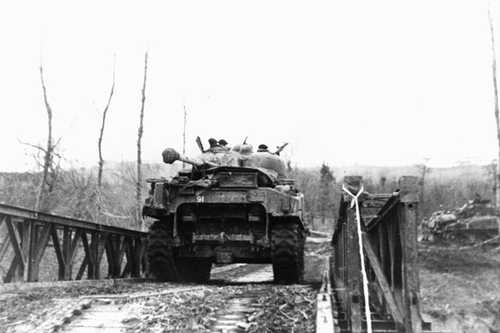
New Zealand Firefly with countershaded gun.
Sherman Firefly 1C of the 18th New Zealand Armoured Regiment crosses an Italian bridge, 1945. The gun is reversed, and the painted "countershading" camo is clearly visible on the underside of the barrel's forward part. Countershading is a form of camouflage widely used in the animal kingdom (birds, dolphins, sharks ...). The idea is that if the upper part of an object is darker in appearance than the lower, the object will tend to blend into the background, especially from the side. The technique is widely applied to military aircraft and ships. In the case of the Firefly's 17-pdr gun, the reason for using it was to make it difficult for the enemy to pick out a Firefly supporting "standard" Shermans as a priority target. The "Sherman Register" website carries a copy of a very interesting document on this subject at http://web.inter.nl.net/users/spoelstra/g104/firefly-cam.htm. This is an extract from the "Middle East AFV Technical Letter, 26 January 1945", titled "Camouflage of 17-pr Gun Mounted in Sherman Tank". The document discusses two methods of camouflaging the Firefly's gun to make it appear that the tank is a "standard" vehicle - countershading, and fitting a dummy gun to the rear of the turret (to make it appear that the tank had only a "standard" 75mm gun when the turret was reversed). These methods could be used together on the same tank; however, a number of reasons were advanced by users as to why the countershading method was, by in large, preferred. One interesting point is that the compilers of the AFV Technical Letter regarded the fitting of a dummy muzzle brake half-way down the barrel (that is to say, just to the rear of the countershaded part) as "essential to provide a clar cut termination of the untreated portion of the barrel.". Well, maybe so - but the examples posted In Here recently seem to reflect the fact that dummy muzzle brakes were seldom actually fitted; the "termination" was likely more often to be provided by painting a darker ring at the start of the "untreated portion", if indeed even this was done. I suppose this probably reflects the good sense of tankers in the field; after all, the "standard" Sherman 75mm gun did not have a muzzle brake. The "countershading" certainly succeeded in confusing me in one of the Firefly 'photos I put up recently ... Best regards, JR.
This is a companion discussion topic for the original entry at https://www.ww2incolor.com/gallery/other-forces/46139/new-zealand-firefly-with-countershaded-gun.

